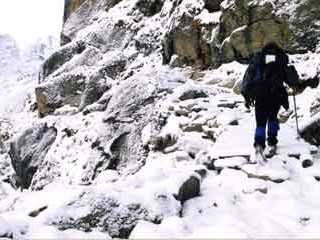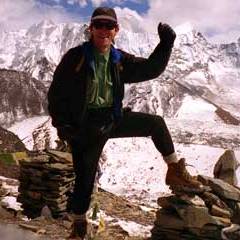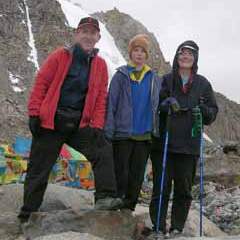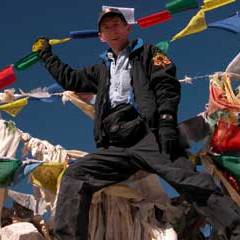
It snowed overnight at Gokyo, so I had to break my own trail returning to Namche Bazaar

On Chukung (4750m) in October 1997

Jerome Ryan, Peter Ryan, and Charlotte Ryan on the Kailash Dolma La (5636m) in 2006

On Larkya La (5213m) trekking Around Manaslu
|
What does it take to be a high altitude trekker?
1. Mental Strength
- Stay focused -
When you are feeling horrible,
it is cold and windy, and your brain is starved of oxygen, you need
the will to put those discomforts into the
back of your mind and stay focused on getting the next step taken.
- Get into a rhythm - F.S.Smythe in his book
The Kangchenjunga Adventure described it perfectly:
"... learn something of the secret that makes for good uphill walking at high altitudes; it is rhythm.
Heart and lungs must keep in time with the movements of the legs.
Each upward step must synchronise with the breathing.
It does not matter how many breaths are taken to each step, as long as always the same number are taken.
Once let this synchronisation fail, and it is necessary to stop and puff."
- Break your goal into small chunks - It can become mentally overwhelming to be at the bottom
of a 1000m hill. I try and break it down into smaller chunks so I can see progress.
I spot a house a quarter of the way up and try and reach it. When I get there I briefly rest and set my sights
on another intermediary goal. Before you know it, you will be on top.
2. Get physically fit
- Exercise - I exercise more and
more intensely in the eight to ten weeks leading up to a trek. In addition to an hour of daily
hiking, I hike about 25km on the weekend mainly through ravines and parks.
I walk up and down small hills and a set of steps many times.
- Simulate your trek - I use the exact
equipment I will use on the trek to ensure everything is in order, whether
it be my boots, walking stick or rainproof outer shell. Although it’s just
common sense, you’d be surprised at how many people foolhardily start
trekking in a new pair of hiking boots. As I get closer to the trek, I even
fill my knapsack with the exact contents I will carry with me.
3. Get good equipment.
- Hiking boots - The most important part of your body
when you trek are your feet. So, it is critical that you buy good
hiking boots. I paid $300 for my boots in 1997 and I still use them today.
- Hiking socks - I use polypropylene liner socks beneath my wool
socks. I have never had a blister in all my treks. I have seen other trekkers
who skimp on boots or socks and have blisters the size of dollar coins.
- Trekking pole -
I use only one pole - if the Pakistani Balti porters use only one stick, then that is good enough for me.
A trekking pole can help save your legs during endless uphill grinds and reduce stress on your knees, hips, and lower back.
They are also useful for negotiating trails or creek beds with uneven terrain.
- Clothing layers - I cover my thermal
underwear with trekking tights and a light trekking shirt. If it is cool I
add my fleece jacket. If it rains or gets cold I add my waterproof pants and
Gore-Tex outer shell.
- Sunglasses - The sun is especially strong at high altitude. Make sure you
apply plenty of sunscreen, and wear a good pair of sunglasses.
- Sleeping bag - I use a
three-season sleeping bag rated for 0C because it is lightweight. I keep my
thermal underwear and socks on to add extra warmth. I wear my balaclava to
ensure I don’t lose heat through my head.
As it gets colder, I leave more and more of my clothing on.
4. If you are trekking by yourself
- Pack light - The old story of a climber
cutting his toothbrush in half to save weight applies equally to trekkers.
It is ok to wear clothing for two or three days in a row, and then hand wash them.
My backpack holds only 35L and weighs about 12KG fully loaded.
My backpack just fits as carry-on luggage, so I avoid the hassles of checked backage
with their danger of getting lost or delayed.
- Study the route - I try and memorize my trekking route, including
how long it will take to get from one place to another. I close my eyes
and visualize the route. I plan where and when I will take my key photos. When
you’re actually there and you are oxygen starved or very tired, having the
route implanted on your brain helps you keep on the right track. Even then,
I’ve been lost many times.
- Plan your overnight stops - I pore over maps of
villages and read as many guidebooks as possible to plan which lodges or
hotels I will head for.
- Study weather patterns - I read about the
weather patterns, when is it sunny and when the clouds typically roll in. I
learn where the mountains are versus my position and the direction of the
sun.
5. Stay healthy
- Bring plenty of medicine - When you are trekking there will be
very little, if any, medical help quickly available. So, it is critical
that you carry your own. In addition to the standard sunscreen, lip
balm, bandages, Pepto Bismol, Immodium, and Ibuprofin, I carry
prescription medicine.
- Drink plenty of water - To stay hydrated, I try and drink
four to five litres of liquids a day, including water, soup, and tea. I carry two litre water bottles and get
my cook or the person in the lodge kitchen to fill them with boiling water.
If I run out I drink bottled water or soft drinks.
I do not drink any alcohol until I get down from the trek.
- Do not drink bad water in its disguises - Brush your teeth with
clean water. I never eat salads. At lower elevations, do not drink anything with ice
cubes.
- Eat carefully - Eat food that is hot and you know has been freshly cooked.
You can eat fruit if you peel it. I do not typically trust meat in a village and so become a vegetarian.
I have become very sick with lots of vomiting when I break
this rule and eat from a street vendor or a local shop.
- Use hand sanitizer -
I just squirt a small amount on my hands and rub them together to keep them germ-free.
I do this constantly - before I eat, after touching things, after using the toilet, etc.
- Avoid altitude sickness - Do not go too high too fast.
Cerebral Edema (brain) and Pulmonary Edema (lungs) are extremely serious and can even kill you.
How old you are and how fit you are do not seem to matter. I met
a German trekking group of eight people at Lobuche near Everest, and the oldest
and youngest could not go on. As a precaution I take Diamox.
- Read - This is only a brief introduction to staying healthy. I recommend you
read guidebooks to get a more complete list.
|

